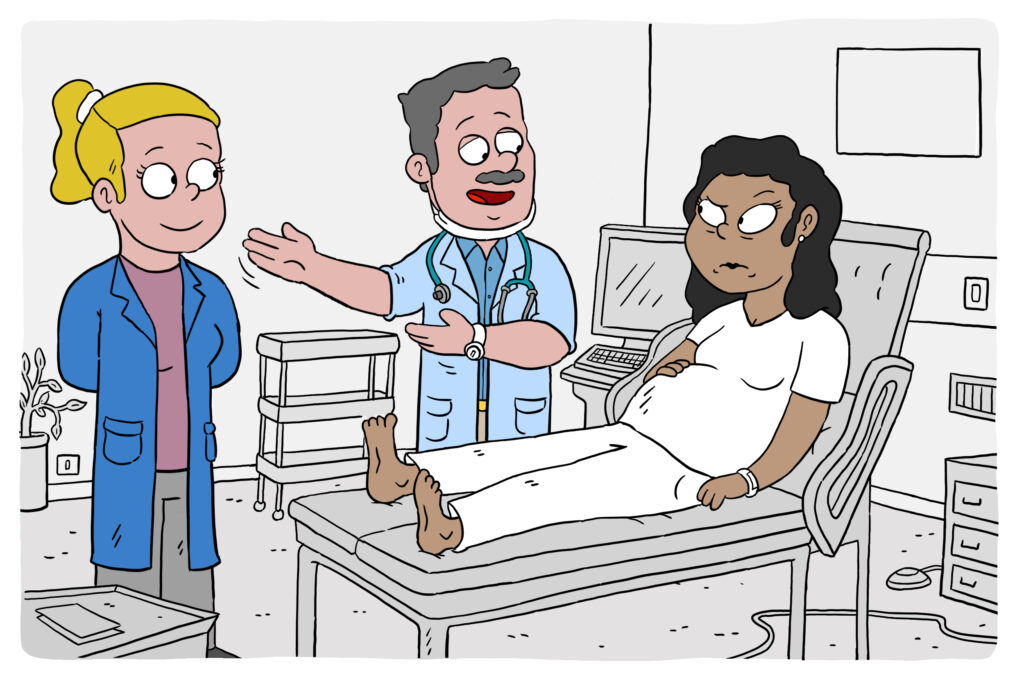Surya is pregnant with her first child and is about to give birth. She finds it all very exciting and asks the family doctor, Peter van Mierlo, who will help her on the day of delivery. Her family in India is used to having the delivery accompanied by a gynecologist. She wants that too; she likes the idea. Peter explains that a midwife is normally present, unless it threatens to be a difficult delivery. He immediately introduces her to Monique, the midwife who will accompany Surya.

Another view
Surya is disappointed. “Soon I will give birth for the first time. I find it all quite exciting!” she reflects. “That’s why I asked Dr. van Mierlo if I could count on the women’s doctor. But now I hear there’s a midwife there! Is that even a real doctor? Am I really in good hands? The doctor is not clear!” But Surya dares not say anything.
Peter is pleased. So far, everything looks good with Surya, and there will probably be no complications during labor. “Friendly woman,” he thinks. “It will be quite exciting so far from home. She didn’t say much. I think she’s confident. And Monique is a very sweet midwife!”
The misunderstanding: the doctor is unclear
Surya goes home worried. A midwife is not a doctor. What if something goes wrong? It will be an exciting few last weeks. Doctor van Mierlo was not clear in her perception. But she couldn’t help but respect him.
Peter van Mierlo was pleased with the visit. The pregnancy is going normally and Surya had no questions. If something hadn’t been clear she would have asked.
The circumstances
In India, the patient looks up to a doctor, an authority. India is a society that values authority. It took some getting used to before that Surya had to deal with Doctor van Mierlo, as a kind of middleman, who, moreover, always received her in casual clothes and told her she could say Peter! A doctor in India would never do that. That one exudes expertise and authority. The patients like that too; it gives clarity.
Surya has long doubted whether Dr. van Mierlo himself was a real doctor. Now he comes with a midwife…. Nice woman though, that Monique but Surya had counted on specialists, in a safe environment, not at home. In India that is not possible anyway, the houses are different and if the woman has to go to the hospital quickly, there is often no good infrastructure. About the Netherlands, she is not so sure yet.
But Surya is not used to calling the doctor on that. She is uncertain and even a little angry. But Dr. van Mierlo doesn’t seem to have time for her.
In the Netherlands, we also have great respect for the family doctor, gynecologist and obstetrician, but the specialist is not necessarily the only or best option. In addition, giving birth at home is perceived as a luxury, thanks in part to the availability of the midwife.
In our egalitarian culture, people treat each other as equals. The patient thinks with you. Clara expects the same, and if you have questions you can ask.
The connection
In India, authority and family is very important. It is a more hierarchical, “we” society. Clara can expect Surya, in his presence, to communicate indirectly and not put her questions and concerns on the table unasked. If she smiles, remains silent or stands up, it does not mean she does not have those questions. Peter should also know that Suraya expects an “authority,” a specialist, at the delivery.
Peter can pay better attention to Surya’s body language and address her concerns by describing the midwife’s specialty in advance. In addition, it may help to tell her that the midwife also attends births in her own family. Finally, Peter can ask if she would like to briefly repeat exactly what was discussed. This is not condescending, but a way of giving Suraya the floor and inviting her to ask further questions. And it prevents the doctor from being unclear.
Of course, Surya will gain more and more confidence in the Dutch approach and learn to stand up for herself. Also with Dr. van Mierlo. But it is precisely these very personal and exciting circumstances in which cultural differences become more important.
In short
Summary for the physician:
- Accept that the patient looks up to the doctor and at the same time has less confidence in someone who is not a doctor.
- Create the opportunity for the patient to speak.
- Be extra alert to body language.
- Provide more explanation and ask if the patient can summarize the explanation.
- This patient comes from a “we” culture: share your own story.
Summary for the patient:
- Accept that the doctor expects you to ask questions when you have them.
- Accept that a Dutchman doesn’t do that much with your body language.
- Express your concern and ask for clarity.
- The doctor comes from an “I” culture, who is not so likely to talk about their own experiences.
Want to read more about culture dimensions?
Important to know
This anecdote is based on stories shared with us. Connect2Us strives to highlight the dilemma from both sides and not to label people or suggest that one or the other should behave differently. Awareness by those involved is enough to move toward each other. Without pretending to be very different. Connect2Us wants to help readers recognize and avoid prejudice. Read about prejudice, discrimination and racism here.

